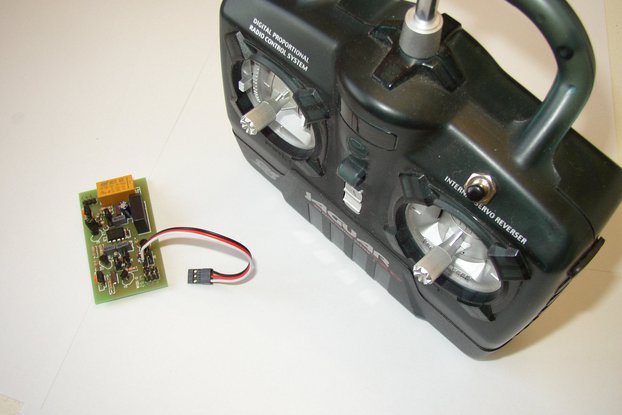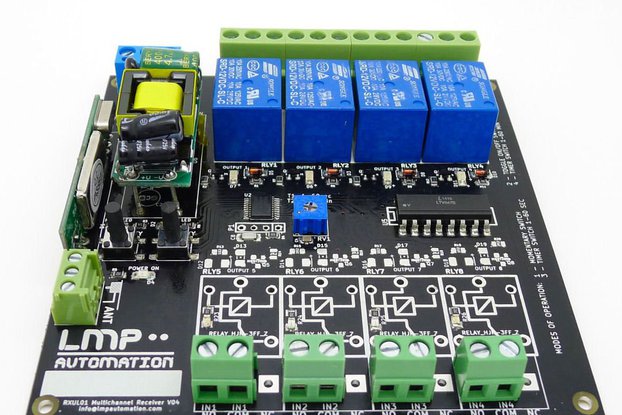A 3 channel transmitter and receiver with relay outputs.
Designed by CraftyCrow in United Kingdom
This product is no longer available for sale.
The seller may be offering an improved version or it may be hanging out on the beach, enjoying the retired life.
Transmitter The transmitter has two buttons for three channel operation. With each button press a different code is transmitted which is never used again. There are trillions of unique codes and mill…
Read More…The transmitter has two buttons for three channel operation. With each button press a different code is transmitted which is never used again. There are trillions of unique codes and millions of unique transmitter identities.
When first powered up, each transmitter button controls a separate number generator whose mode of action depends on your combination of button presses. Once the LED flashes, your transmitter identity is locked and ready for use.
RF link provided by the RFM68CW.
Operating frequency 434.050 MHz ISM band channel 40.
Modulation type: On-Off Keying. OOK uses 70% of the bandwidth of FSK and half the power.
Maximum transmitter output power 0dbM or 1mW.
Current consumption: less than 150nA quiescent and 6mA for transmit. Transmit duration: 50mS.
Tested operating temperature: -20C – +50C
Weight with battery fitted: 23g Battery: CR2032
Dimensions: 61mm x 36mm x 16mm (dimensions of supplied case)
The receiver is three channel and each relay can be individually selected to be either latching or momentary (100mS) action. Relay 3 is actuated by pressing both transmitter buttons together. There is one button on the receiver to learn a new transmitter and the receiver can learn 3 transmitters in a FIFO setup. A fourth transmitter would push out the first and so on. Any number of receivers can pair with the same transmitter. The receiver will only respond to two identical packets spaced 1mS apart sent from a known transmitter.
There are several antenna options for the receiver from antenna free operation, all the way up to a Yagi-Uda array antenna. A pad is provided on the PCB to solder coaxial cable braid. Input impedance is 50 ohm. Designed for 12VDC battery operation, although a regulated DC power supply capable of 100mA at 12VDC would be suitable, the receiver has reverse polarity protection and will operate effectively over the voltage range of 10VDC to 14VDC. A ‘flat’ car battery unable to start an engine would still provide enough current to drive the receiver.
Designed to fit into a Camden Boss BIM2003/IP case (not supplied), there are mounting holes for fixing with M3 bolts for your custom installation.
Relays are rated at 8 amps with a maximum voltage rating of 250 VAC and 30 VDC @25 degrees Celsius ambient for resistive loads.
RF link provided by the RFM65CW.
Current consumption: less than 4mA quiescent and a maximum of 50mA with all three relays activated.
Tested operating temperature: -20C – +50C
Weight: 40g
Dimensions: 91mm x 53mm x 17mm (receiver board)
8 meters (26 feet) without a receiver antenna fitted. 150+ meters (492 feet) with a quarter wave length of wire.
Rolling code refers to key-presses sending a code from a number generator to prevent a replay attack. Since the transmitter and receiver use the same algorithm, the next sequence (48 bits long) is generated from previous sequence along with the decrypted serial number and control bits. An output is actuated for an authenticated key. A look-ahead feature in the receiver allows for key-presses when the transmitter is out of range of the receiver.
Workshop alarm setting and remote lighting.
Caravan lighting and alarm arming.
Remote model rocket launch controller.
Very low current consumption and long range with a simple antenna.

$7.80
Free Shipping!

$48.88
Free Shipping!

$21.30
Free Shipping!

$47.00
Free Shipping!
By clicking Register, you confirm that you accept our Terms & Conditions
We recognize our top users by making them a Tindarian. Tindarians have access to secret & unreleased features.
We look for the most active & best members of the Tindie community, and invite them to join. There isn't a selection process or form to fill out. The only way to become a Tindarian is by being a nice & active member of the Tindie community!
